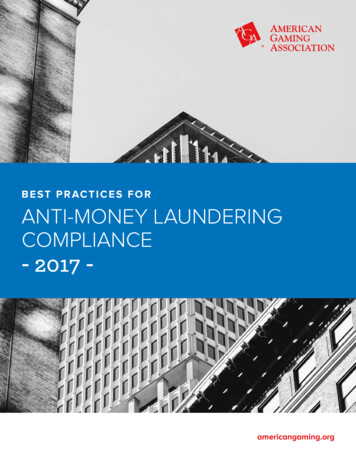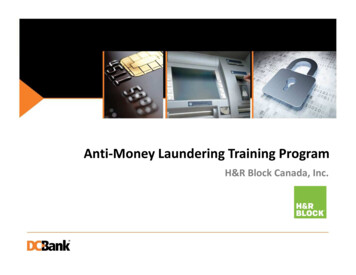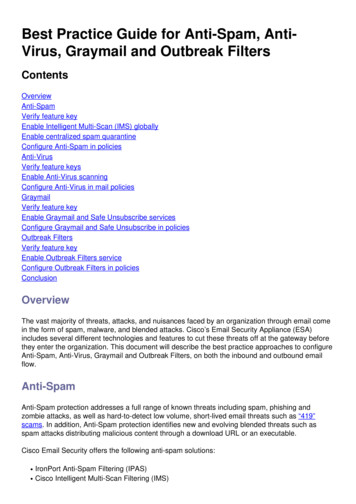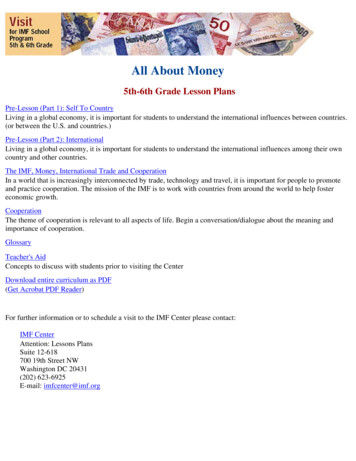
Transcription
B E S T P R AC T I C E S F O RANTI-MONEY LAUNDERINGCOMPLIANCE- 2017 -americangaming.orgBest Practices for Anti-Money Laundering Compliance 20171
TA BL E O F C ON TEN TSINTRODUCTION 3BACKGROUND 4CASINOS’ CULTURE OF COMPLIANCE6RISK ASSESSMENT 7State Regulatory Requirements7Gaming Volume and Character7Range of Financial Services8Characteristics of Certain Games8Country Risk 8Politically Exposed Persons (PEPs)8Patron Behaviors 8Results of Independent Audit9and IRS ExaminationPatron Characteristics 9BSA/AML COMPLIANCE OFFICER10EMPLOYEE TRAINING 10PREVENTATIVE STEPS 11CUSTOMER DUE DILIGENCE 12Patron Identification and Verification12Ongoing Due Diligence 13TRANSACTION MONITORING 14POTENTIAL SUSPICIOUS ACTIVITY 15Gaming Floor Activity 15Race and Sports Book Activity16Cage-Focused Activity 16Information from Back of the House17SUSPICIOUS ACTIVITY REPORT 17REVIEW PROCEDURESAUDIT PROCEDURES 19Independent Testing Procedures19for CTRsIndependent Testing Procedures20for SARsRECORDKEEPING AND RETENTION 20CONCLUSION 21GLOSSARY 22ABO UT AMERI C A N GA MING ASSOCIATIONThe American Gaming Association is the premier national trade group representing the 240 billionU.S. casino industry, which supports 1.7 million jobs in 40 states.AGA members include commercial and tribal casino operators, suppliers and other entities affiliatedwith the gaming industry. It is the mission of the AGA to be the single most effective champion of the industry, relentlessly protecting against harmful and often misinformed public policies, and paving a pathfor growth, innovation and reinvestment.Best Practices for Anti-Money Laundering Compliance 20172
I N T R O DUC TI ONThe U.S. gaming industry is one of the most heavily regulated and controlled business sectors across the globe. Inaddition to comprehensive and stringent state gaming regulations, U.S. gaming operations are subject to federal antimoney laundering (AML) requirements.The modern casino is an entertainment venue that offers its patrons highly regulated gaming, often combined with hotels,multiple dining options and live entertainment. To facilitate gaming activity, casinos ordinarily provide some financialservices to their patrons. Although the vast majority of patrons visit casinos for entertainment, leisure and diversion, thoseengaged in illegal activity may attempt to use the casino’s financial services to conceal or transfer illicit wealth.To discourage such behavior and safeguard the integrity of the casino industry and the U.S. financial system, casinocompanies have developed effective risk-based programs in an effort to ensure compliance with the legal requirements ofthe federal Bank Secrecy Act (BSA) and associated anti-money laundering (AML) statutes and regulations.This document is an attempt to distill the practices that a wide range of casinos and Internet gaming sites have adoptedto meet these challenges. This document uses the term “casino” to cover both in-person and lawful Internet gamingoperations, because the BSA/AML compliance effort applies to both.This document is not intended to be a checklist of actions required of every casino and should not be applied arbitrarily toany individual situation, or on a blanket basis. In some instances, industry practices may go beyond a legal requirementestablished by statute or regulation, so this document should not be considered a guide to those legal requirements.In addition, because AML programs are risk based and casinos have different risk profiles, individual casinos will havegood reasons for departing from or modifying a procedure in this document, or for developing supplemental or alternativeprocedures, including appropriate approvals and documentation of decision-making.The goal of this document is to provide a resource for industry and law enforcement to help guide their efforts to protectthe gaming industry and the broader financial system from money launderers and others involved in illegal activity.Best Practices for Anti-Money Laundering Compliance 20173
BACKG R O U N DSince 1985, commercial casinos have been defined as “financial institutions” under the Bank Secrecy Act (BSA).Accordingly, they must file currency transaction reports (CTRs) when a patron either provides to the casino or takes awayfrom the casino more than 10,000 in currency during a casino’s defined 24-hour gaming day.Casinos also must file suspicious activity reports (SARs) when a casino knows, suspects, or has reason to suspect that atransaction aggregating at least 5,000:gInvolves funds derived from illegal activity;gIs intended to disguise funds or assets derived from illegal activity;gIs designed to avoid BSA reporting or recordkeeping requirements;gUses the casino to facilitate criminal activity;gHas no economic, business or apparent lawful purpose; orgI s not the sort of transaction in which the particular patron would be expected to engage, and the casino knowsof no reasonable explanation for the transaction after examining the available facts.More broadly, the BSA also requires casinos to design and implement risk-based AML programs that include, at aminimum, a system of internal controls, policies, and procedures to assure ongoing compliance, which should includeprocedures for using all reasonably available information to determine:When required by BSA regulations, the name, permanent address, Social Security number, and otherinformation, and verification of the same, of a person;g gWhether SARs need to be filed;gWhether any other record required under the BSA must be made and retained;gInternal and/or external independent testing for compliance;gAppropriate, ongoing training of casino personnel;gAn individual or individuals charged with assuring day-to-day compliance (the “AML officer”); andgL astly, to assure compliance by integrating and sharing data as appropriate and feasible among different partsof the casino enterprise.In the interest of maintaining the integrity of gaming, each casino company implements a comprehensive and robust antimoney laundering compliance program that identifies and mitigates its risks and also ensures that it submits appropriateCTRs and SARs as required.A discussion of criteria for casino compliance programs appears at the website of the Financial Crimes EnforcementNetwork of the U.S. Department of the Treasury (FinCEN).This risk-based compliance effort involves many complexities. For our patrons, casinos are generally not viewed asfinancial institutions, but rather entertainment venues they enter and leave as it suits them. Many patrons are not, andnever will be, personally known to casino employees.Even those patrons who become identified to the casino, because they are frequent visitors or because they requireassistance with financial transactions, ordinarily have no reason to disclose to casino employees their business orprofessional activities. Most are, after all, at the casino to pursue entertainment.Some, for legitimate personal reasons, may not care to have their gambling activities known. In addition, the relativelysmall number of patrons who may attempt to launder funds through casinos take considerable pains to conceal thatpurpose from the casino.Best Practices for Anti-Money Laundering Compliance 20174
To help address money laundering risks, casinos have developed comprehensive risk-based programs to identify patronswhose gaming activity approaches the CTR reporting threshold. That requires the aggregation of currency transactionsfrom several different parts of the casino: the gaming tables, electronic gaming machines, and casino cage activity,including credit (or marker limit) and front-money transactions.To detect and report suspicious activity, casino employees and supervisors must make complex, nuanced judgmentsbased on available information about a patron’s activities. The legal standard for filing a SAR is a subjective one, applyingto situations where the casino “knows, suspects, or has reason to suspect” reportable activity.Moreover, as stressed in the National Money Laundering Risk Assessment issued by the U.S. Department of the Treasuryin June 2015, “most often criminals who use casinos to launder illicit proceeds do it through gambling and spending onentertainment”1 – the exact same activities that the casino’s other patrons are pursuing. Consequently, there is often littleobservable basis for distinguishing between those patrons laundering funds in the casino and all other casino patrons.In some situations, suspicions can be confirmed or disproved only with information that is ordinarily unavailable to thecasino, or by making inquiries of the patron – for example, concerning the source of the patron’s funds. Senior managers– rather than front-line employees – may be best suited to determine whether to make such an inquiry and to conductthe inquiry.For instance, the matter may involve issues that the casino ordinarily would have no business reason to investigate, andsome patrons may have little or no incentive to review those issues with the casino. The involvement of senior managersmay facilitate the interaction with the patron, as well as signal the importance of the inquiry.National Money Laundering Risk Assessment, 0Risk%20Assessment%20%E2%80%93%2006-12-2015.pdf, page 75, (June 2015).1 Best Practices for Anti-Money Laundering Compliance 20175
CAS INO S ’ C ULTURE OF C OMP LIAN CERisk-based AML compliance efforts and a strong culture of compliance are essential to the casino industry.2To promote and foster a culture of compliance, casinos should allocate substantial employee time to AML compliance,which includes:Establishing a system of internal controls and policies and procedures to assure ongoing compliance withAML requirements;g g g g Ensuring independent testing of AML compliance, of a scope and frequency that matches the money launderingand terrorist financing risks present;Training casino personnel, as warranted for individual jobs, in the identification of unusual financial transactionsor suspicious activities, in the recording and aggregation of currency transactions, and all legal requirementsand the casino’s compliance policies and procedures; andDesignating an individual or individuals responsible for assuring day-to-day AML compliance at all venues.Casinos also should consult with FIN-2014-A0073, which discusses “Promoting a Culture of Compliance.”Forging effective working partnerships with law enforcement agencies is another important way to nurture a culture ofcompliance, ensuring that employees understand how BSA-required reports are used to achieve national policy goalsthat may override business concerns.4Casinos also have found it useful to participate in the voluntary information-sharing program with other entities defined asfinancial institutions under Section 314(b) of the USA PATRIOT Act.There is no more effective way to foster a positive culture than to have the casino’s senior leadership and Board ofDirectors (whether directly or through the Board’s Audit or Compliance Committee) engaged in the AML complianceeffort, receiving periodic updates on regulatory developments, changes to the program, resources, and audit findings byregulators and by other independent compliance reviews.“A good compliance culture is one where doing the right thing is rewarded, and where ‘looking the other way’ has consequences.” Please see TreasuryBlog Note by Acting Director of FinCEN, Jamal El-Hindi, Culture of Compliance and Casinos, liance-and-Casinos.aspx (finding that “casinos appear to be steadily improving their anti-money laundering efforts.”).2 See also, Advisory to U.S. Financial Institutions on Promoting a Culture of Compliance, FIN-2014-A007 (Aug. 11, 2014), y-fin-2014-a007.3 A recent study by Ernst & Young for the American Gaming Association surveyed officials from twenty-three law enforcement and gaming regulatoryagencies and found that the casino industry has made concerted efforts to enhance AML compliance and reporting. Investing in America’s FinancialSecurity: Casinos’ Commitment to Anti-Money Laundering Compliance, p. 27. ML%20Research%20Report%20Final%20011916.pdf4 Best Practices for Anti-Money Laundering Compliance 20176
R I S K AS S ESSMEN TBecause every financial institution is potentially at risk of being used for illegal purposes or accepting funds that wereobtained illegally, casinos should identify and assess their money laundering risks and adopt effective measures tomitigate those risks.The risk assessment should be tailored to each specific casino venue and the nature and characteristics of its location,enterprise and customers. Many factors may be relevant to the risk assessment for a specific casino, but the riskassessment process begins with asking basic questions:First, what are the entry and exit points at the casino for patron funds that may come from illicit sources?g g g Second, what casino departments or employees are best positioned to detect the entry and exit of such funds?Finally, what are characteristics of transactions that may involve illicit funds, or of patrons who are more likely toengage in suspicious activity?In answering these questions, a casino will assess the BSA-related risks present at different parts of its business.Regulators, independent auditors, and law enforcement officials may also provide important guidance concerning risksthat are arising in the financial system generally, and in the gaming industry specifically.There is no substitute for the exercise of judgment based on experience with casino transactions. Nevertheless, somebasic characteristics of a casino’s business can guide the assessment of the risk that a casino transaction may involve theproceeds of illegal activity or involve money laundering.State Regulatory RequirementsEvery state that grants casino licenses also imposes exacting regulation on casino operations, though specificrequirements vary from state to state. State regulations define the games that can be offered and the rules of each game;they also establish what financial services can be offered and the procedures casinos must follow in providing them. Stateregulation also will extend to the nature of the surveillance and security measures employed at the casino.Gaming Volume and CharacterDifferent gaming venues may have differing risks based on their unique product mix and customer pool, while risks mayevolve over time as a venue’s business model changes.Because money launderers often deal with substantial amounts of money, they may be drawn to larger casinos withhigher gaming activity, where large-value transactions are more frequent and less likely to draw attention, and where thecasino’s surveillance systems may have greater capacity.For the same reasons, money laundering may be more likely to involve patrons bringing large amounts of money to acasino and playing games at higher-dollar values. Accordingly, larger gaming venues will likely need more AML/BSAcompliance procedures than smaller dollar volume casinos.Nevertheless, smaller volume casinos must be alert to a patron’s departure from ordinary patterns of play and thesuspicious use of the financial services offered by the casino; similarly, the structuring of transactions to avoid reportingrequirements can occur at any casino, regardless of business volume.Best Practices for Anti-Money Laundering Compliance 20177
Range of Financial ServicesThe broader the array of financial services available at the casino (e.g., front-money deposit accounts, marker limit/creditextensions, wire transfer procedures, the receipt and issuance of negotiable instruments, the offering of safe depositboxes), the greater the opportunity for a money launderer to exploit several different services for illicit purposes.Characteristics of Certain GamesThe rules of certain games may make money laundering more likely. For example, if a game allows patrons to bet eitherside of a bet (e.g., baccarat, craps or roulette), confederated patrons might bet both sides in order to launder fundsthrough the game. Similar risks may arise in the case of sports betting when a patron places a bet with a legally operatingsports book on behalf of an unidentified third party, concealing the origin and owner of the funds.5Because poker is not a house-banked game, transactions at the poker tables may occur between customers, rather thanwith the casino. Accordingly, the casino may be less likely to detect potential suspicious activity because poker -- unliketable games, race and sports book wagers, or electronic games -- does not afford the casino the ability to determineverified win/loss. If a casino does not permit cash wagering in poker rooms, the risk of money laundering may becorrespondingly reduced.Country RiskSome patrons with casino accounts may be deemed to present a higher risk if the casino learns that they are nonresident aliens or foreign nationals or residents of countries that have been defined by the United States as jurisdictionsof concern for narcotics trafficking, human trafficking, money laundering, terrorism, or other forms of illicit finance, or if theforeign nation has been identified as non-cooperative by the Financial Action Task Force, or if the foreign nation has beenidentified by Transparency International or a similar reputable organization as having a high level of public corruption.6Politically Exposed Persons (PEPs)Also known as Senior Political Figures, Politically Exposed Persons (PEPs) are individuals who have been entrustedwith a prominent public function, or individuals who are closely related to such persons. PEPs and their transactionsmay warrant further inquiry and consideration by the casino, such as investigating their source of wealth or funds. Asappropriate, casinos should identify and assess the risks of both foreign and domestic PEPs.Patron BehaviorsUnusual patterns of patron behavior on the gambling floor may suggest the risk of money laundering. For example, apatron’s betting activity or his financial transaction activity may increase significantly without explanation.Or a patron may appear to be coordinating his gaming with another patron or patrons (e.g., passing chips or cash backand forth) in an attempt to evade notice. Or a patron might abruptly change the methods he uses for bringing money intoor out of the casino, or unexpectedly use multiple sources or multiple destinations for funds. A patron also may requestmultiple monetary instruments for a jackpot or wager win.All of these behaviors may be entirely legitimate, but casinos should be attentive to the risk that they are not. Many ofthese considerations are detailed further in later sections of this document.See FinCEN Correspondence with the American Gaming Association Regarding Sports Betting Conducted on Behalf of Third Parties, www.fincen.gov/statutes regs/guidance/pdf/01162015.pdf, (Jan. 16, 2015).5 For example, see the State Department’s annual International Narcotics Control Strategy Report and regulations and guidance issued by FinCEN.6Best Practices for Anti-Money Laundering Compliance 20178
In addition, the U.S. Department of the Treasury noted in its 2015 National Money Laundering Risk Assessment, thatmoney laundering activity at a casino most often involves exactly the same activities – gambling and spending money –that all casino patrons engage in.That reality may limit the utility of applying data analytics to casino information, given that licit and illicit activity so oftenlook the same to the casino’s compliance team. Nevertheless, data analytics may help identify certain specific types ofillicit activity, such as “bill stuffing” in slot machines.Results of Independent Audit and IRS ExaminationIndependent auditors’ evaluations and Internal Revenue Service (IRS) examinations of the casino’s AML complianceprogram should be carefully analyzed and reviewed. The casino should undertake corrective actions in response toissues that arise during an examination or audit, and revise its AML program accordingly or make a determination that nosuch action is necessary.Patron CharacteristicsIn some instances, a casino may learn information about a specific patron which warrants further inquiry or examinationof the patron’s transactions. Examples of such information include formal actions against the patron by law enforcementagencies, public reports of negative information concerning the patron’s integrity, or evidence that the patron is underinvestigation by law enforcement.When such reports arise about a patron, casinos may wish to review any previous transactions with the patron that mayappear suspicious in light of the newer information. Casinos may also determine to review such patron’s future activity, ifany, after a prescribed period of time (e.g. 90 days).In addition, information about the patron’s financial situation may be relevant, to the extent known by the casino, including(as examples) the presence of IRS tax liens or personal bankruptcies in recent years.Because all of these criteria are necessarily general, individual casinos have adopted a range of implementationmeasures and guidelines that aim to detect, block, and report efforts to present illicit funds at casinos.The following discussion of available compliance techniques should not be viewed as mandatory for every casino.Variations in patron mix, games offered, volume of gaming, and many other factors may render some steps listed belowless applicable to a specific casino, or may warrant measures in that casino that are not identified in this document. Adiscussion of risk assessment factors for casinos (FIN-2010-G002) appears at the FinCEN website, www.fincen.gov, alongwith responses to Frequently Asked Questions.Best Practices for Anti-Money Laundering Compliance 20179
BS A/ AML COMPLI A N C E OFFICE RAs required by federal BSA regulations, at least one employee at a casino must be designated as responsible forcompliance with BSA and AML requirements, policies, and training, and should be available to other employees toconsult on related questions as they arise. The BSA/AML compliance officer should be fully knowledgeable of the BSAand all related regulations.The BSA/AML compliance officer should also understand the casino’s products, services, customers, entities, andgeographic locations, and the potential money laundering and terrorist financing risks associated with those factors, aswell as how BSA-required reports are used by law enforcement agencies.The BSA/AML compliance officer, along with the AML compliance function more broadly, should be vested withappropriate authority and resources to implement the program and assist the casino in managing risk.EM PLOYEE TRA I N IN GOngoing training on AML procedures and BSA compliance requirements should be provided to employees who assist withor review patron transactions that may be subject to the BSA. The extent and intensity of the training should vary accordingto the responsibilities of the employee, but should address CTR and SAR reporting and the casino’s AML Program.Training materials should be updated regularly to reflect regulatory and enforcement developments under the BSA. Ifsuch regulatory developments may warrant a revision in the casino’s compliance practices, relevant personnel shouldreceive information on a timely basis about both those developments and any revised casino practice.The following categories of employees should receive training at least once per year, and more frequently if changesin the law or circumstances require it. Following the training, the employees should be required to pass a test on thesubjects covered and to sign an acknowledgement form agreeing to comply with company BSA/AML policies.Training should extend to the following general categories of employees: hose engaged in the operation of casino games (table games, poker, slots, keno and bingo, and sports betting),Tat least beginning with supervisors and above;g g g g g g g asino marketing employees, including domestic and international hosts, branch office employees, and ifCapplicable special events employees;Cage employees;Surveillance employees;Property compliance and AML compliance employees;Audit employees, including Internal Audit and Fraud Department employees; andSenior gaming management, Board of Directors, Audit Committee or Compliance Committee, as applicable.Training on BSA and AML policies of the casino also may be incorporated in job training for other casino employees, suchas dealers.The casino’s AML compliance performance, as well as the compliance actions of individual employees, should be a factorin performance reviews of those employees involved with BSA compliance, and should be considered in calculatingcompensation and bonus and in determining any negative personnel action, including performance improvement plansthrough to termination from employment.Best Practices for Anti-Money Laundering Compliance 201710
P REVENTATI V E STEPSCasinos should consider adopting policies and procedures that have the purpose of preventing patrons from attemptingtransactions that have a higher likelihood of involving BSA violations or other violations of law. Such policies andprocedures should be tailored to the casino’s specific business profile.Some examples of such policies and procedures may include:Requiring that “ticket-in/ticket-out” (TITO) redemptions at slot machine kiosks be capped at an amountdetermined by the risk assessment for such transactions at that casino.g g g g g g g g g g g Barring cash for cash exchanges above a threshold consistent with the risk assessment for such transactionsat that casino, while permitting senior management to approve such exchanges above that threshold for anappropriate business purpose (e.g., foreign currency exchanges for established patrons at reasonable levels).Such approvals should be documented.Declining to accept cash to purchase a casino check or other monetary instrument or to initiate a wire transfer.This would not restrict the cage from issuing a check or funds transfer for documented casino winnings, or fromdoing so in legitimate circumstances. Such approvals should be documented. Concern would be heightenedwith respect to checks or wire transfers which originate from a labor union, charitable/non-profit organization orfoundation, Interest on Lawyer’s Trust Account (“IOLTA”) or other type of trust account. A casino may determineto reject and/or reverse such checks and wire transfers.I ssuing casino checks and wires to a patron only for the amount of his/her winnings, in the absence oflegitimate circumstances for such actions (e.g. the remaining funds from a cashier’s check which already hasbeen negotiated).A check for winnings should be payable only to the patron, and a wire transfer should be made only to thepatron’s account or, if applicable, to the account from which the originating wire was received.Casinos may wish to consider adopting procedures allowing cage management or senior management toapprove making checks and/or wires payable to the patron’s business or other account, or to someone otherthan the patron, when an appropriate business purpose for the action is documented, and/or an appropriateconnection is documented between the patron and the business.Suspending a patron’s loyalty club account and/or barring the patron if the patron’s activity has generated thefiling of an incomplete CTR and the patron has declined to produce the required information, until the missinginformation is provided. Filing a SAR for the episode should be considered. In such instances, the patron may beprohibited from further gaming and redemption of complimentaries. enior management should have discretion on such matters if the patron is cooperative, the complimentariesSwere already earned, and the expectation is that acquisition of verifying identification will be facilitated bymaintaining the patron relationship.Although not required by law, directing International Branch Offices of the casino to adhere to the samerecordkeeping and reporting requirements under the BSA that are consistent with the laws of the jurisdiction inwhich the International Branch Office is located.Additionally, all traveling marketing executives, prior to travel outside the U.S. should be trained on the laws thatrelate to gaming and marketing for the specific jurisdiction(s) they are visiting. If a traveling marketing executiveis authorized to conduct a financial transaction in an international location, the casino may also need to reportthe transaction under the BSA.Eliminating cash play at poker tables.Best Practices for Anti-Money Laundering Compliance 201711
CU STO M ER DUE DILIGENCEThe risk-based approach to BSA compliance is driven by a periodic risk assessment that identifies those customers andtransactions that potentially pose the greatest risk of money laundering, so higher levels of scrutiny and evaluation canbe applied to those situations, when appropriate.As noted above, the risk assessment allows casinos to determine and implement proportionate controls to mitigate thedifferent levels of risk present in differing circumstances.Patron Identification and VerificationNo front money or marker limit/credit account or safety deposit box agreement will be opened, nor will any transactioninvolving such services be conducted, unless the patron provides a full name, a permanent address and (for U.S. citizens)a Social Security number (as required by law or regulation). This requirement does not apply to the establishment or useof player loyalty club accounts.No transaction(s) known to be reportable under
Best Practices for Anti-Money Laundering Compliance 2017 3 INTRODUCTION The U.S. gaming industry is one of the most heavily regulated and controlled business sectors across the globe. In addition to comprehensive and stringent state gaming regulations, U.S. gaming operations are subject to federal anti-money laundering (AML) requirements.










